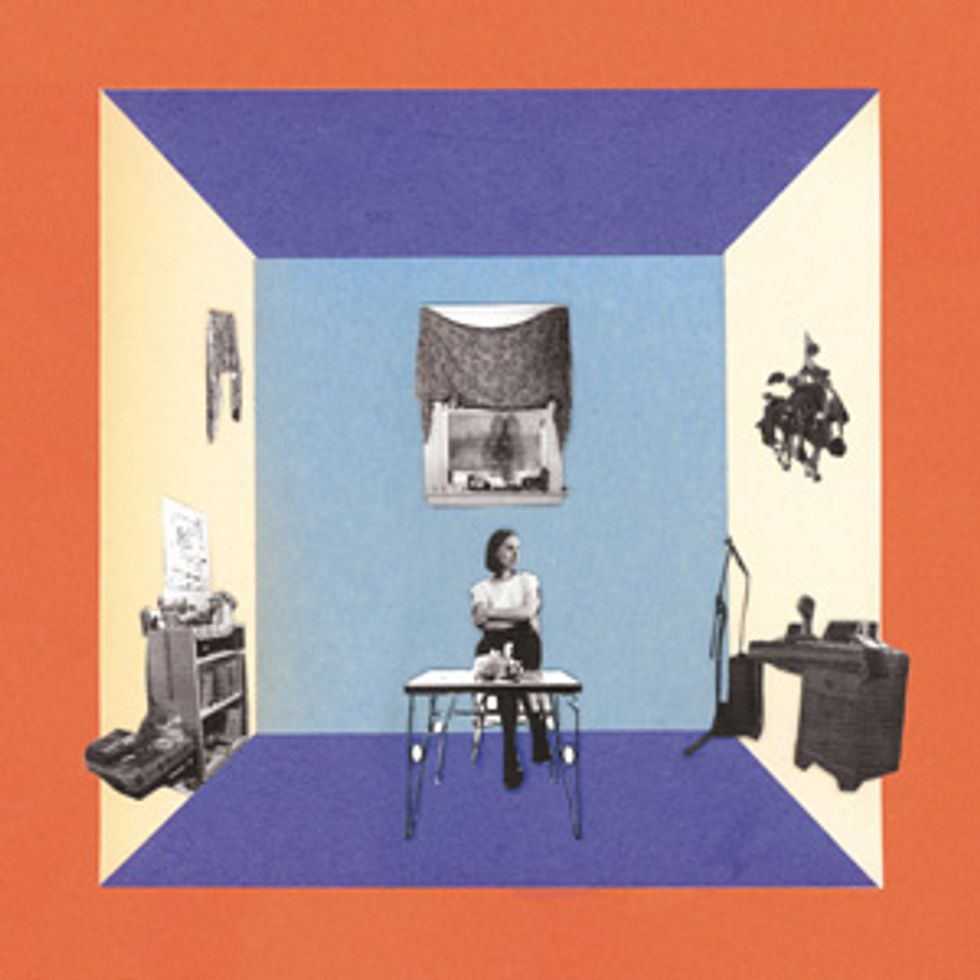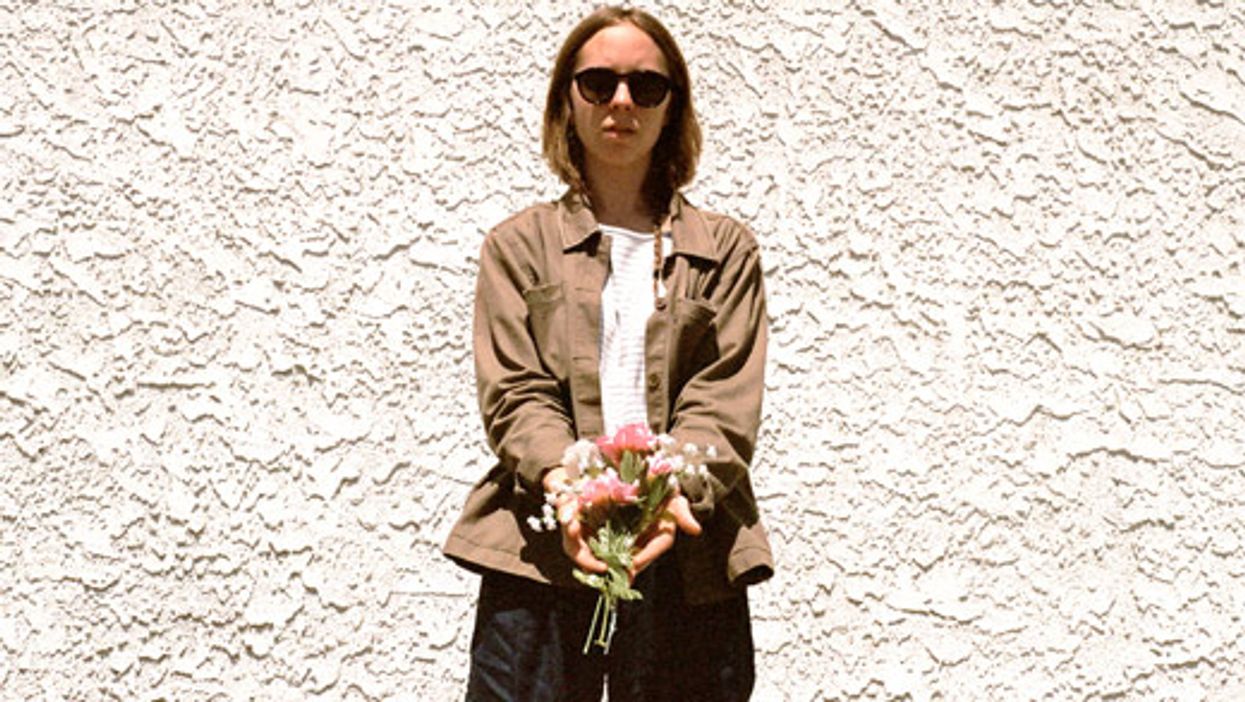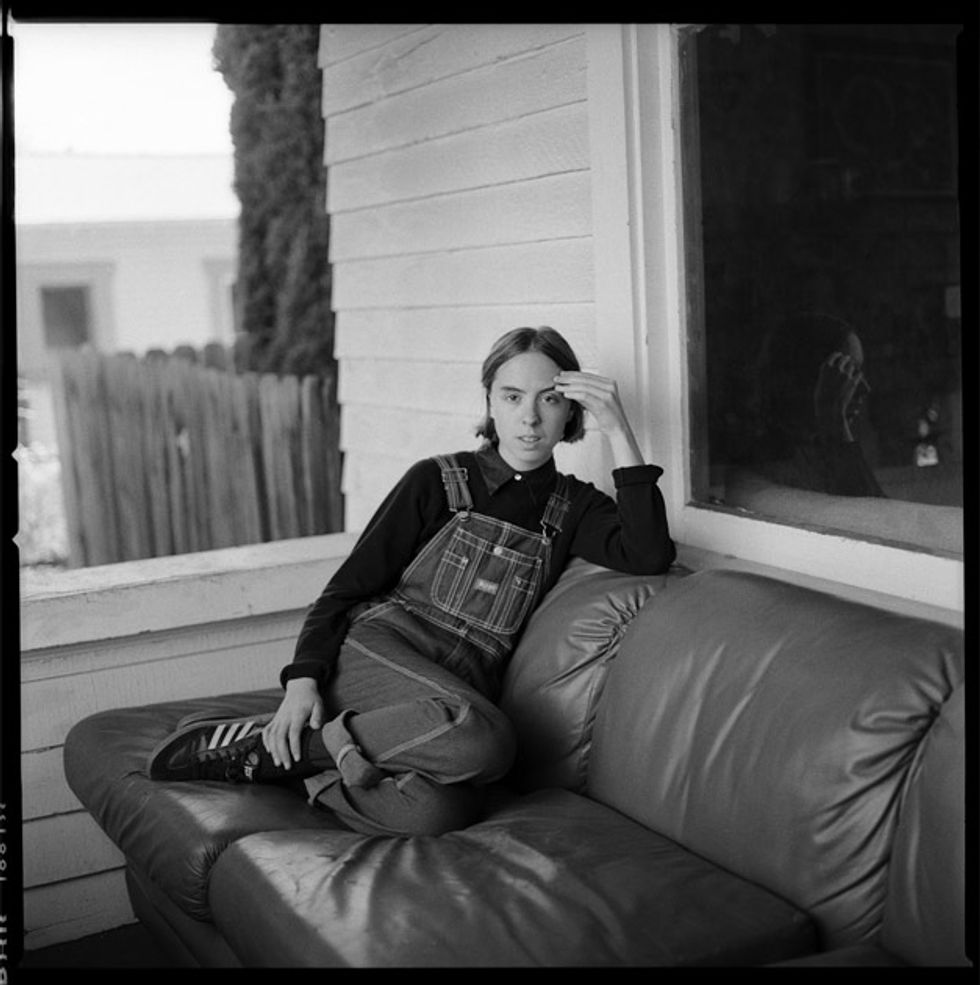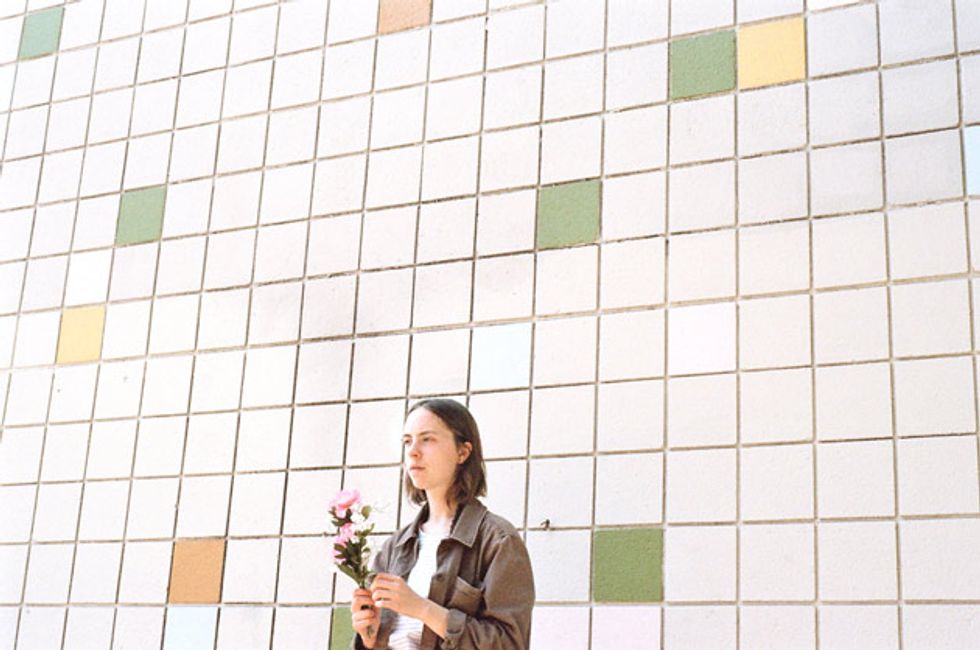There's an old debate among musicians on the topic of musical literacy. Some claim that a working knowledge of theory and notation detracts from creativity, while others say the more you know, the greater your musicianship.
Meg Duffy, 26, a formally trained guitarist and singer-songwriter in Los Angeles by way of upstate New York, makes a strong case for the latter argument. Duffy's command of fretboard harmony and her melodic inventiveness—not to mention her mastery of effects pedals—have made her a busy collaborator. In the last several years, she's enhanced the music of indie artists like Kevin Morby, Mega Bog, and Weyes Blood, among others.
But Duffy's vision is best appreciated by spinning her debut LP, Wildly Idle (Humble Before the Void), which she released under the name Hand Habits. On the album, she sets her songs—as well as poetry by Kayla Ephros, Catherine Pond, and Lucy Blagg—to rich soundscapes that beckon you to peel back and discover their many sonic layers.
Reached via telephone, Duffy explained how she arrived at these uncanny sounds, how she captured them in the bedroom of a Los Angeles house, and about how music theory has informed her creative decisions.
some amazing effects.
There are so many great guitar sounds on Wildly Idle. What's their primary source?
I just used one electric guitar, and I've only ever had one. It's a Fender Lone Star Strat with a rosewood fretboard and single-single-hum Seymour Duncans. I use the tremolo system a lot. I made it really tight with an extra spring, too, because I don't like it when it has a lot of give. It's just not as physical when it's loose.
Why do you only have one guitar?
I've never found another guitar that I like that I was willing to spend money on. I've been thinking about getting a Jaguar or a Mustang, though. I want something that I can play behind the bridge. I had the pleasure of opening for Wilco, with another group that I play in, and it was great to hear those pointy sounds from behind the bridge. But yeah, I haven't gotten another guitar because I love mine so much.
What's your history with that Strat, and why do you love it so much?
It was the first guitar I ever bought for myself. I started out on an Austin Strat copy. After about a year, my uncle Richard, who is a luthier, was like, “Okay, now you should get a real guitar," and he took me to a place called Parkway Music in Clifton Park, New York. I went in wanting a white or seafoam green one, but I ended up liking this sunburst Strat so much I bought it. It was 900 bucks, which was a lot, because I was 18 and about to go to college.
The neck always feels so good to me. And I love the way the way the guitar sounds, although as my ear is evolving, I'm starting to recognize why it would be nice to have another guitar, in terms of tone. I don't always like the midrange on it.

Duffy's debut album as Hand Habits was recorded mostly in her bedroom using an Avid Mbox interface, Pro Tools, and a few borrowed microphones.
Maybe part of it is sentimental. I feel I've built up a relationship with my guitar. I know it so well, and I can pull off the things I want to execute on it. It's like driving a car.
Let's talk about the rest of the gear. What effects and amps did you use on the record?
I was originally using a vintage Music Man that was left in the house that I was recording in. I tracked a couple of rhythm guitars on that, and then it started to shit the bed. It wasn't having any output at all, and those things are notoriously heavy. I also didn't have a car, so I was like, “I can't really fix this. I can't bring it anywhere." I also didn't want to put money into it, because it wasn't mine.
And then, halfway through making the record, I bought a Fender Hot Rod Deluxe. That's always a fun amp I go back to because it's so simple and it has a lot of bass. I tend to roll off the high end on anything I do. I started using that amp, and then—I don't know if it was a tube problem or there was something rattling within the cabinet—any time I'd play the note D, it would rattle. That started driving me nuts, so I recorded the rest of the guitar on the album direct, through an [Avid] Mbox.
What about effects?
I have a bunch of pedals, which were always in the mix. I used an [Ibanez] TS9DX [Turbo Tube Screamer], which I keep on the TS9 setting. I also use a Boss Mega Distortion, which is really cool. I have a Strymon El Capistan that I use on guitar, as well as vocals, because the reverb sounds great, and it always adds a nice fake-tape sound. Their stuff is so good. I wish I could afford more.
I love using a Diamond Quantum Leap delay—especially in the pitch ramp mode—and after that I'll put the Strymon, with a really long decay time, so I get a lot of oscillation. The Quantum Leap's pitch ramp is foot-controllable, and when I hold down the footswitch, it gives off a subtle “whoo"—a lot more subtle than other pitch-shifting pedals.
And then there's the looping. I use a [Line 6] DL4 to build soundscapes, and I also have the Electro-Harmonix 45000, a 4-track looping recorder that includes some amazing effects. I like to run both loopers at the same time.
Duffy plays only one guitar, a Fender Lone Star Stratocaster, but lately has been eyeing Jaguars and Mustangs, so she could get “those pointy sounds" by plucking strings behind the bridge. Photo by Chantal Anderson
The guitars sound very lush. Are you using anything for reverb?
Yes. I have a reverb pedal, the DigiTech Polara, that came out not that long ago. I feel like DigiTech gets a bad rap, except for the older stuff, but I really love it, especially the Hall and Halo settings.
What is your musical background?
I started playing guitar and listening to mostly classic rock and blues, because I had an uncle who was playing guitar in a cover band, doing Led Zeppelin and Stevie Ray Vaughan and stuff like that. I was into Stevie Ray Vaughan when I first started playing guitar. I'd listen to his version of “Little Wing" and think, “Wow, I wish I could do that with a guitar." It just sounded so physical.
I was in a lot of cover bands playing that kind of music in high school, jamming with friends, but I was also in the jazz band, even though I couldn't read music yet. I would go home after I got the music and spend hours trying to turn it into tab. After I graduated high school, I went to Schenectady County Community College for guitar performance. I was the only female in my guitar program.
do that with a guitar.'"
What was that like?
It just made me feel that I wanted to be better than the boys at everything I did, always. I had a really good teacher, who was mostly a bluegrass player. I was in a pick-style program. We learned a lot of chordal melodies and we would have to read through Paganini pieces, too. But then, for my recitals, I would always play jazz chordal melodies. I think the last piece I performed was “Misty" or something like that. There was a lot of improv going on, and I always played a lot with people in the program.
How did you get into songwriting?
Once I was out of college, I taught guitar for a little while, and I started writing songs about that time. I didn't really share them with anyone. I think I was still writing, at that point, in a theory brain, because of all the part writing and voice leading I'd studied and become obsessed with. I would write all these weird guitar parts that I would now put on and be, like, “This is lame." I wasn't accessing this part of the rest of the creativity that I'm learning how to access now. It took me a little while to bridge the gap between having all this knowledge and being able to apply it with a creative mind.
What do you think helped you bridge that gap?
Just not being afraid of simple chord changes. Not being afraid of a I–IV–V progression, or staying in the key of G major, or just playing what comes to me, rather than “How can I make this interesting first?"
Meg Duffy's Gear
GuitarsFender Deluxe Lone Star Stratocaster with Seymour Duncan pickups
Amps
Fender Hot Rod Deluxe
Effects
Boss DD-7 Digital Delay
Boss MD-2 Mega Distortion
Diamond Quantum Leap QTL1 Delay
DigiTech Polara Reverb
Electro-Harmonix 45000 Multi-Track Stereo Looping Recorder
Ibanez TS9DX Turbo Tube Screamer
Line 6 DL4 Delay Stompbox Modeler
Strymon El Capistan dTape Echo
Strings and Picks
D'Addario EXL116 strings (.011–.052)
Dunlop Jazz III picks
These days, do you ever feel tempted to use more advanced harmonic concepts, or is it something that you've moved beyond?
I think that there's a lot of it in my playing, even when I'm not aware of it. I was in a session a couple months ago, and I wasn't thinking I was playing anything theoretically advanced, but the guy who hired me said, “Wow, you're in that mode up there. What is that?" To me, it's just that I'm using the major scale in a different way. It's not something that most contemporary pop, folk-rock people think about when they're writing.
Would you say your training has given you a wider range of options when it comes to diatonic harmony?
For sure. And I always go back to the sentiment that when someone's really well read, and they have studied philosophy or language, they're usually able to express a very intricate thought without overwhelming someone with language.
Where did you record the album?
I recorded two of the songs, “All the While" and “In Between," in Saugerties, New York, with the help
of my friend Kevin Laureau. We co-engineered, and he helped me with a little arranging on one song.
The rest of it I recorded in my bedroom in a house in Highland Park [a historic Los Angeles neighborhood]. I'd just moved there, and Jeremy [Earl] from [the record label] Woodsist had heard some of my older songs and was really into them. He said, “We should do a record," and at first I thought, “Okay, cool, but I don't know when I'll have enough songs," because I wasn't really writing that much. As soon as the opportunity presented itself, I was surprised at how much I started writing.
But in terms of recording, I was creating all these roadblocks for myself, and venting to friends: “I don't know how I'm going to do this record. I think I'm going to have to work a lot first, and I want to go into a studio." Then I thought, “These are all problems that I'm creating for myself. I have an Mbox and Pro Tools on my computer. I can borrow microphones and I can just do this on my own."
After graduating high school, Duffy went to Schenectady County Community College for guitar performance. She was the only female in the guitar program. Photo by Robbie Simon
What gear did you end up borrowing?
In terms of microphones, I borrowed a Shure SM7B and a Blue Dragonfly, one of those condenser mics, which sounded great on vocals. As for Pro Tools, I was using the LE version, and just whatever basic plug-ins come with that. I'm a big fan of the stereo pan—there's a lot of hard panning on the record.
What did you learn from the process of recording yourself?
Anything I didn't know how to do, I just looked at a YouTube tutorial—things like how to automate reverb without creating another track. If I couldn't find an answer or didn't have the capability, I would try to figure out how to do it a different way, which was cool.
It sounds like you sweated the details.
I'd actually try not to spend that much time on every track. I've been in recording situations without time constraints, and I think people can get really obsessed with options, in terms of getting sounds. I didn't have a lot of experience, obviously, up until this point. So I made a promise to myself not to spend too much time on the sonics.
In terms of songwriting, do you start off with a strong idea of what you want before tracking or do you write your songs as part of the recording process?
I usually have a strong idea of what I want a song to sound like—at least for the rhythm section—and it's usually very simple. My process is, like, “Oh, I'm going to record a scratch guitar and vocal, and then I'll record over it and just do a lot of layering."
Obviously, there's a lot of overdubbing, because it was just me. A lot of the songs started with just a guitar and me singing a scratch vocal, and then I would add the real guitar and the real bass before spending a lot of days trying to come up with some cool percussion parts.
On “All the While," you play some slide guitar, first just single notes, and then harmonized, with some intriguing effects.
That was just me running my guitar through a [Boss] DD-7. During the take, Kevin live-manipulated the oscillation, to get it to feed back. The DD-7 pedal was before that Diamond Quantum Leap that I was telling you about, with the pitch modulation. It's super subtle, but you can kind of hear the warble at the end of it.
“Book on How to Change" has other cool guitar moments, like the spontaneous lead lines beneath the surface.
I did a couple passes of that one where I was like, “Okay, I'm just going to solo over the whole thing, and see what I get." There are some cool little riffs in there that I was pretty proud of. I feel I should apologize to Nels Cline for ripping him off so much, but he's my hero. And then just a lot of the soundscape building was fun because it's like jamming with yourself.
You're going on tour soon and will presumably be playing these songs with a band. What do you think that will be like?
I'm still learning how to communicate to a band how I want things played, especially since I made the record mostly on my own. Actually, I'm rehearsing these songs with other people for the first time next week, and it'll be interesting because I get a little bit protective of some parts. There are so many subtleties that come out of making a record, and then the songs kind of grow around the recording, and they feed into each other.
It'll be fun to let go of that—a little bit at least—and allow the other players to have their own voices within these songs I've created. I'm interested in facilitating a good time for people, too, musically speaking, and something that's fulfilling for them, as well as for me and the listeners.
YouTube It
In this recent solo performance recorded live in Paris, Meg Duffy creates a huge shimmering sound with her trusty Fender Lone Star Stratocaster and delay pedals.














![Rig Rundown: Russian Circles’ Mike Sullivan [2025]](https://www.premierguitar.com/media-library/youtube.jpg?id=62303631&width=1245&height=700&quality=70&coordinates=0%2C0%2C0%2C0)












![Rig Rundown: AFI [2025]](https://www.premierguitar.com/media-library/youtube.jpg?id=62064741&width=1245&height=700&quality=70&coordinates=0%2C0%2C0%2C0)




















 Zach loves his Sovtek Mig 60 head, which he plays through a cab he built himself at a pipe-organ shop in Denver. Every glue joint is lined with thin leather for maximum air tightness, and it’s stocked with Celestion G12M Greenback speakers.
Zach loves his Sovtek Mig 60 head, which he plays through a cab he built himself at a pipe-organ shop in Denver. Every glue joint is lined with thin leather for maximum air tightness, and it’s stocked with Celestion G12M Greenback speakers.











